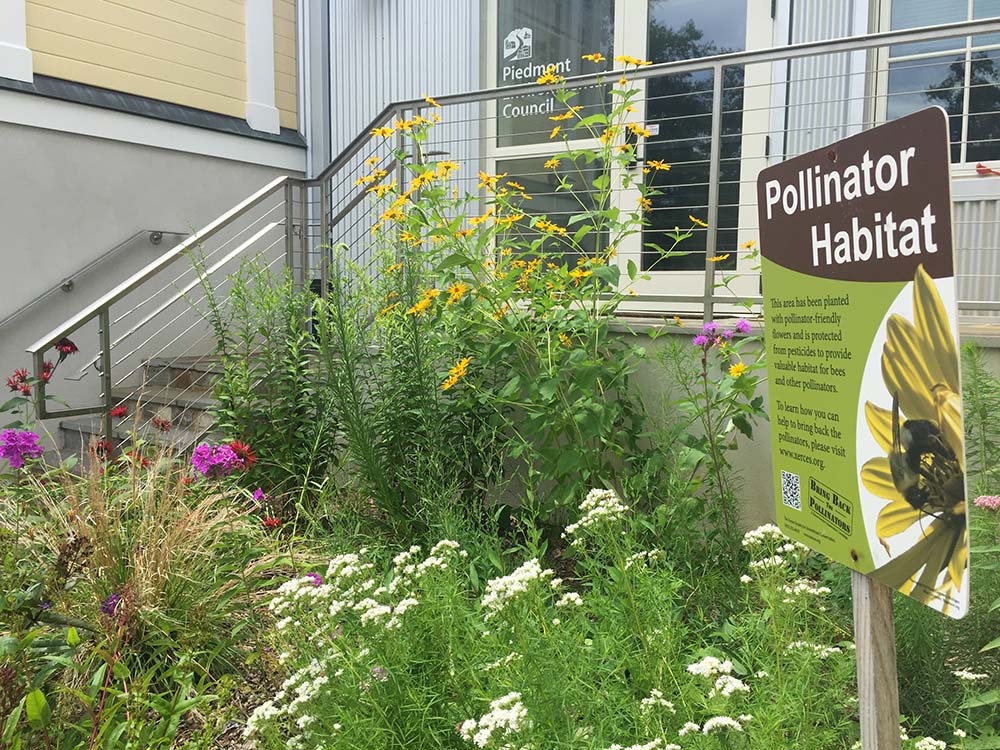
Creating a habitat for native bees
You don’t have to be a genuine bee keeper to help our native bees. You can create a place for them to thrive right in your backyard garden. First, assess your location. Is your project area in full sun, partial sun or is it fully shaded? Soil drainage also matters, whether it’s average, dry or wet soil. Once you know this, pick the plants that would thrive in that specific environment.
Choosing native plants is best for native bees, as they have adapted to each other over time. You can visit the Virginia Plant Atlas at vaplantatlas.org to see a selection of native species or review PEC’s “Go Native Go Local” guide at pecva.org/gonative to find retailers selling natives.
It’s nice to pick a suite of plants that will bloom through the entire growing period, which is early April through late October, locally. Also, make sure the plants you purchase are not treated with pesticides.
If you have selected the right plant for the right place, native plants generally do not need fertilizer or compost. You should plan to water the plants on a regular basis until they are established, and weed around them until they fill out and shade out weeds (usually this takes about one to two growing seasons). Leave dead stems standing through the winter and only clean out the garden in the early spring in preparation for new growth. Do not rake or remove dead vegetation unless absolutely necessary — insects will use the leaf compost to over-winter in, which is healthy for the ecosystem, and therefore our native bees.
Selecting your plants:
- Pollinators are highly visual, and choosing a large mass of color will help them spot your garden.
- Perennials will make up the majority of your plant list, but you should have 1–2 native grass or sedge species and at least one type of spring-flowering shrub or small tree, if possible.
- If you are short on space, pick a few species that attract a wide variety of pollinators such as goldenrod, mountain mint, asters, Monarda and joe-pye weed, to name a few.
- Also include species that are uncommon in the landscape but are desirable to specialist bees or bumble bees. Some examples are golden alexander, bottle gentian and Lance-leaved loosestrife.
- Selecting the appropriate shrub or small tree species depends greatly on the amount of space that you have. Some shrubs to consider for smaller areas are Virginia sweetspire or New Jersey Tea. If you have space for a small tree, redbud is a good choice.
Making a “hotel” for bees:
Bees and other insects vary on the types of nesting structures they prefer, so there’s no ‘one way’ to build an “insect hotel.” If you google the term, you will nd a variety of di erent types of structures. You can pack compartments with natural materials like tree bark, straw, leaves, sticks, etc. The key is to use natural substrate — nothing that has paint, wood stain or has otherwise been treated by chemicals.
Most solitary bees nest in the ground, so you may not attract a wide diversity of them to your insect hotel, but leaf cutter bees (Megachile) and mason bees (Osmia) will be interested. These bees lay eggs in tube-like structures. In the wild, they use dead standing reeds/stems or tree branches. To mimic this, you can bundle bamboo reeds or drill holes into your structure. They are a bit particular about the size of the holes, so make sure you are putting in structures that are the right size for them to use:
- For leafcutter bees, holes should be 1/4″ wide and 2 1/2”–4” deep.
- For mason bees, holes that are 6” deep, 5/16” wide.
- Try to space holes at least 3/4” apart, and never drill entirely through the wood.
Your insect hotel will need maintenance from time to time. Natural materials degrade and will need to be replaced, and any nesting tubes/tunnels that are used will need to be cleaned out, otherwise bees won’t use them the following season.
This article was featured in our Fall 2017 member newsletter, The Piedmont View.
